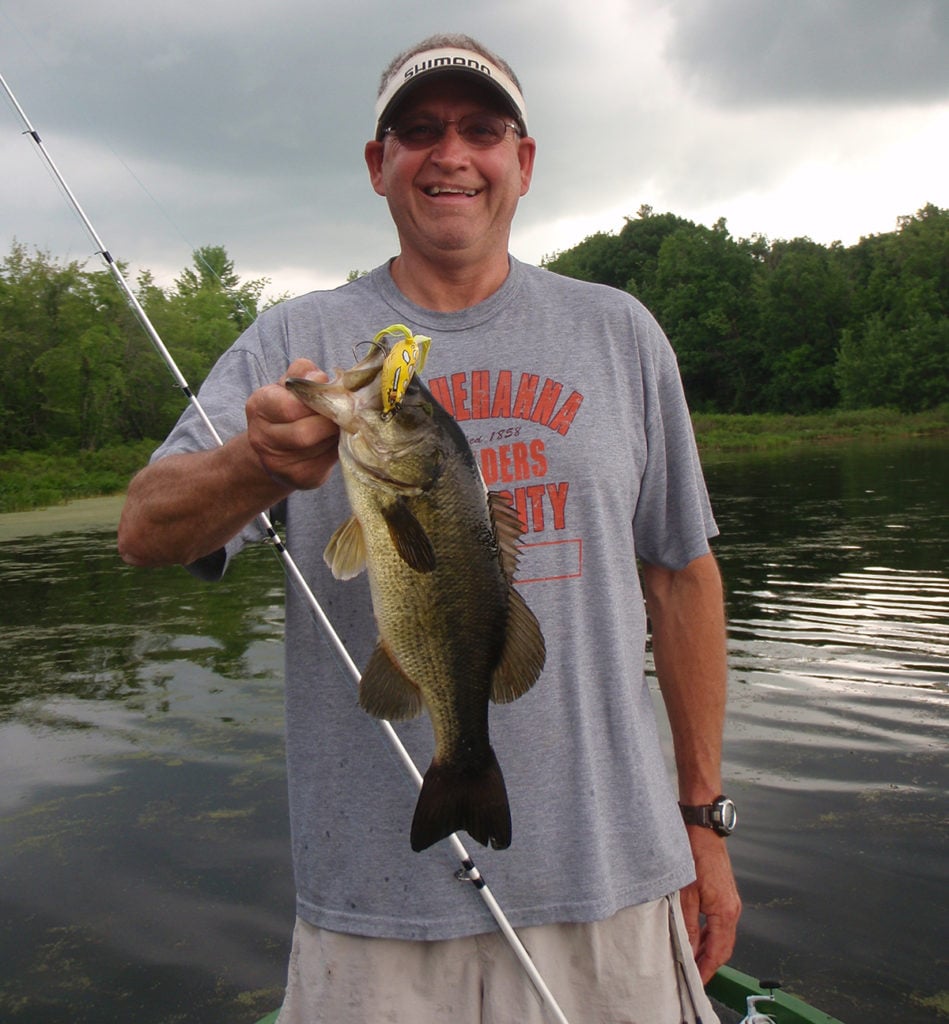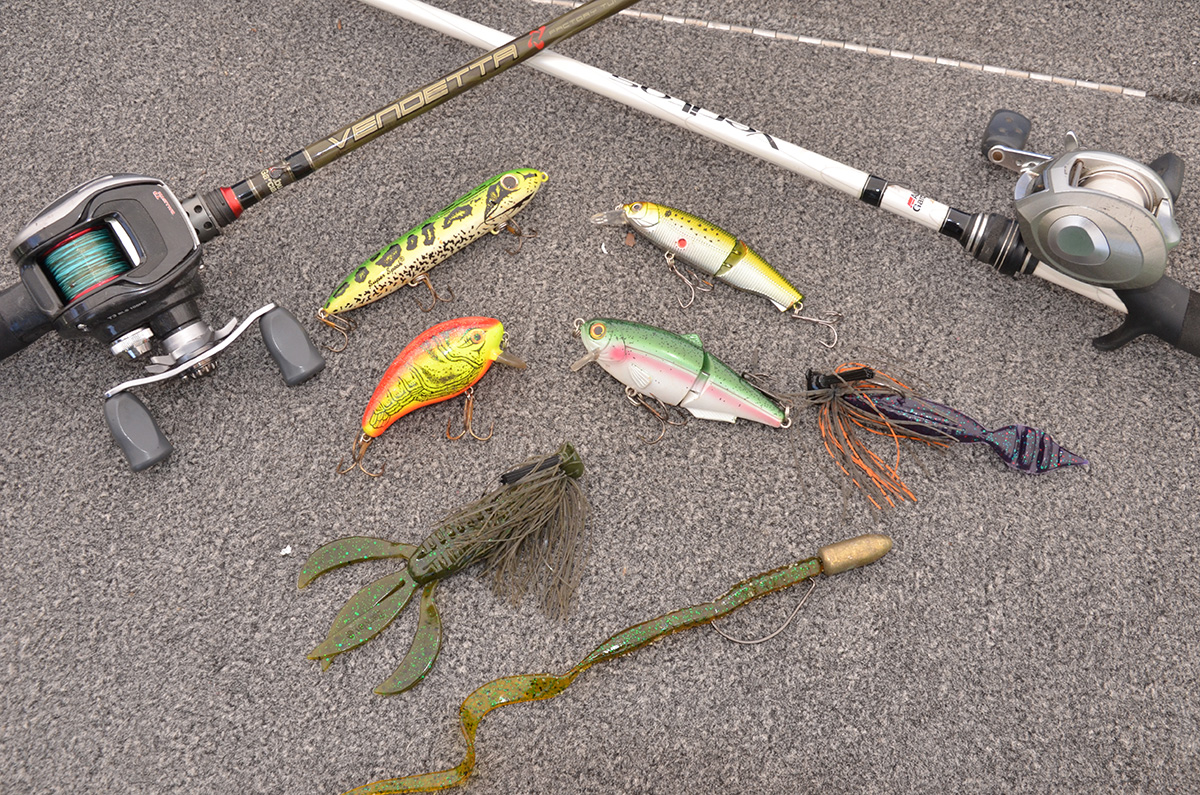
On Long Island many anglers feel it is just a small fish fishery where largemouths are concerned. We have small bodies of water for the most part, no real boat access and cold winters that shorten the growth rate right? Then add in the bucket brigade that has to eat every fish they catch.
If you want to believe these myths, then keep throwing the old stand-by—small spinnerbaits, small Senko and Berkley worms or Tiny Torpedoes. Don’t get me wrong, these baits can and will account for large fish at times, but for the most part, big baits account for big fish. When was the last time you heard of an NFL lineman eating an egg sandwich for breakfast? He usually eats the entire chicken that laid the egg, along with a slab of bacon the size of a small pig. On Long Island, the bass are no different than in some other parts of the country. Feed them a large meal and they are happy. So what constitutes a large offering? I am talking large crankbaits—but not the deep diving models. Worms in the 6- to 10-inch class, swim baits from 4 to 8 inches. With a plethora of lakes stocked with trout each spring, don’t you think large bass are lurking around sucking the fingerlings up like candy? And let’s not leave out the topwater frogs and poppers. The last offering is my favorite—a bulky jig. Let’s explore these baits, and hopefully put you on the path to a lunker bucket mouth.
Hit the Surface
Nothing beats the crash of a topwater plug! It does not matter if it is a 10-inch bass or a 40-pound striper, it’s flat out exciting. For me, fishing a large 6-inch Zara Spook in the early a.m. will bring the big girls calling. The key here is to fish close to structure—weedline, fallen tree or lily pads—and work the lure adjacent. Keep your retrieve as slow as possible, but keep the bait moving side-to-side. If a fish boils, keep working the bait and hold on.
Another great offering is a hollow body frog. A frog can be walked like a Spook, or fished slow and steady and everything in between. The best place however is in the heavy grass or lily pad fields. Working it is simple, hooking the bass is the hard part. After the frog lands, slowly drag it across the cover, allowing it to pause in any open area. If a bass explodes, pause a second or two and reel to try and rip the lips off. After you are hooked, reel fast and keep her from digging into the weeds.
Wormin’
Let’s face it, we have weeds in most of our lakes, and at times, the growth can be overwhelming. At Upper Lake in Yaphank and Massapequa Lake, there are times I really think you could walk on the weeds; they are that thick. These are the times when a heavy punching weight in 1 to 2 ounces and big 10-inch worm work the best—Texas rigged and pegged to the weight. Make your cast and allow the weight to penetrate any hole it can find. Believe me, a 1- to 2-ounce weight, will make it to the bottom. Once on the bottom, slowly lift and drop, only moving the worm a few inches.
Big Smimbaits
Whether you prefer plastic or hard-bodied, a large swimbait is deadly in June. There are still plenty of trout around, and large bass love trout. At most of our lakes there are spillways or dams. Working a large swimbait within close proximity of these is the key. From a boat I like to approach slowly and cast to the spillway and then retrieve. From shore, I make perpendicular casts in all directions swimming it back towards the spillway. Although large swimbaits work well when trout are present, they are just as deadly on the fringes of bluegill beds. If you find a field of beds, cast just outside along the edges of these beds. Oftentimes, bass will be lurking in the shadows waiting for the stray ‘gill to head off their safe environment.
Crankbaits
I have written about it, and been told on more than one occasion, “You cannot fish cranks on Long Island.” My reply is why? In fact, I use some crankbaits that are made to dive 8 to 10 feet with no problem. For big fish, I prefer ones from 2-3/4 to 3 inches that run shallow. For colors, I use the reds and chartreuse or a green hue. These baits to me represent a fleeing bluegill along the shoreline. Pick an area that offers a grass line in the 3- to 5-foot area off the bank. Cast parallel to the shore (for shorebound anglers) or right onto the bank (boaters) and speed crank it. In our area, we could still have fish spawning in June, or just coming off, so either way they are looking to fatten up.
Jig ‘em Up
It is no secret I love to throw jigs. And, it is also no secret I have had more than one bass over 5 pounds, here on Long Island, using jigs. However, just like with any bait, there comes a time and place to use it. In June, I fish a jig probably more than any bait. The jig is versatile, resembles several different size and color baitfish, and you can fish it in the nastiest venues. Give me a 1/2- to 1-ounce jig in either green pumpkin or blue and I’ll catch lunkers!
I use a jig on any fallen timber I see and in any lily field or cattails I can find. I once pitched a jig high in the air into the middle of a cattail field at Lake Panomoka while fishing with Rick Holmberg. He looked at me and said, “What the heck are you doing?” I said there is a bass in there, and within seconds had a plump 4-pounder. Bass lurk in inches of water as long as they have cover. A jig is simple; pitch it into the nastiest area you can find, allow it to settle, then give one to two small, but quick twitches. If no takers, reel up and pitch to another similar area.
Tackle
For tackle, leave the light stuff at home. You are looking for a large bass. One that immediately, after feeling the steel of the hook, will head for cover. She will bury herself into weeds, around stumps or anything else she can find. On the surface, she will flip and crash, shaking her head feverishly to free the hook.

For the most part I use three set-ups. For jigs and topwaters I use a 7-3 Abu Garcia Vendetta VDTC76-6 rod and Daiwa Lexa reel spooled with 30- to 50-pound braid. Funny, because in the salt, fishing for big bass and blues I only opt for 20. But then again, largemouths are going to head straight for cover. The only difference in the line is on the jig rod, I use a 20- to 30-pound test fluorocarbon leader tied with a double uni-knot into the braid.
The second is the Abu Garcia Veritas VRC70-5 and Abu Revo S reel spooled with 12- to 17-pound fluorocarbon. The fluorocarbon line sinks well and has minimal stretch. I use this for the crankbaits or swimbaits.
The last rod is a 7-3 Vendetta VTC-6 rated for 10 to 20 pounds with a Daiwa Ballistic reel spooled with 30-pound braid and topped off with a 10- to 15-foot fluorocarbon leader in 20-pound test. This rod and reel combo casts well and has the backbone to fish heavier lead used to punch through cover.
June is a great month for largemouths—and big ones at that. Give these tips a try, but also remember one thing, you may not catch a lot of fish, but the ones you attract and catch will be trophies. If you are lucky to grab a lunker, snap a quick photo and then release the big girl back in the water.




